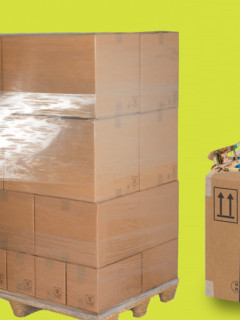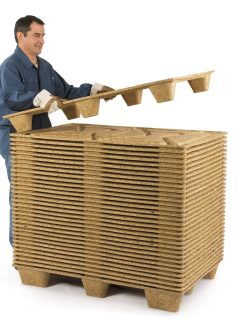Nine wooden blocks, eleven planks and 78 special nails = a relatively simple construction that has revolutionised transport. More than 50 years have passed since the invention of the “europool pallet” (also known as a “europallet”) and during this time goods have been transported safely and efficiently without any problems for export.
Interchangeable Euro pallets
AEuropallet can be any pallet from the Europool exchange system. According to the EN 13698-1 directive, it is a moulded and reusable transport pallet. It is a type of pallet that is not returned to the place of dispatch but is used in the onward transport of goods. The base area is L 1200 x W 800 x H 144 mm and the weight varies slightly according to the moisture content of the wood from 20 – 24 kg. The interchangeable Euro pallet is a so-called four-sided pallet with forked holes for lifting from four sides, i.e. it can be loaded and transported from all sides by floor conveyor, forklift truck or lorry. Europallets are standardised by all international railway companies UIC (Union Internationale des chemins de fer) and comply with the regulations of the European Pallet Association.
TheEuropallet, which can carry up to 2.5 tonnes, was probably invented by German railwaymen who were looking for an optimal solution to make the handling of goods easier than the standard dragging of sacks along the railway. In early 1961, the Interchangeable Pallet Treaty was signed and the official name for this type of product was established as the Euro pallet. This contract set strict standards for the manufacture and repair of the Euro pallet. Supervision and compliance with the rules are contractually enshrined in the European EuroPallet Association. In the mid-1970s, the German railways transferred these rights under the symbol DB, RAL-RG 993, oval O and also the EPAL mark to the institution “Gütegemeinschaft Paletten”). The marking thus became a legally protected mark. There are currently around 500 million of these utility wooden pallets in circulation worldwide and, thanks to their precise dimensions and characteristics, they have become an exchangeable commodity: you will always get back as many pallets as your goods are shipped with. Europallets may only be manufactured and repaired by authorised member companies.
Marking and exchange conditions for Euro pallets
There are numerous provisions on how a euro pallet is to be produced and marked, making it easy to identify a counterfeit product.
EPAL marking for euro pallets :
- EPAL quality marking on the left-hand block.
- Manufacturer’s code, signature staple, manufacturer’s marking – approved railways (e.g. ” ČD” for Czech Railways) .
- For repaired Euro pallets, it is a round test nail on the middle stud on one of the two longitudinal sides.
- The marking of the European Pallet Association EUR on the right-hand stud.
Also for the exchange there are certain points that must be taken into account in order for the pallets to be exchanged:
- TheEuropallet is complete, without any defective or damaged parts.
- The pallets contain identification data such as quality marking, manufacturer, etc.
- The pallet must be manufactured or repaired only by an authorised manufacturer.
- The number of europallets must be indicated on the transport documents.
- The number of euro pallets received by the end customer must be confirmed on the transport documents or delivery notes by the carrier’s authorised officer.
Thanks to the environmentally friendly material from which the pallets are made, the chances of Euro pallets in the future are more than favourable. There is one new feature from next year: the additional introduction of the FRID signalling chip, with which any haulier can find out at any time where a load is at any given moment and when it is likely to reach its consignee.














